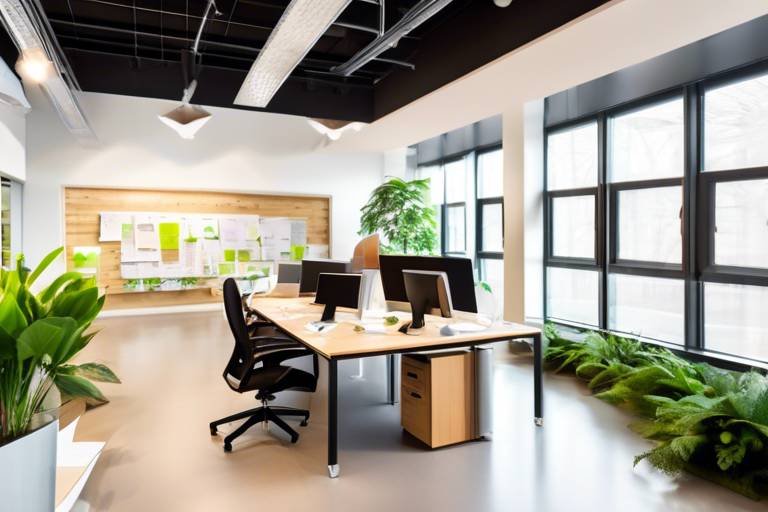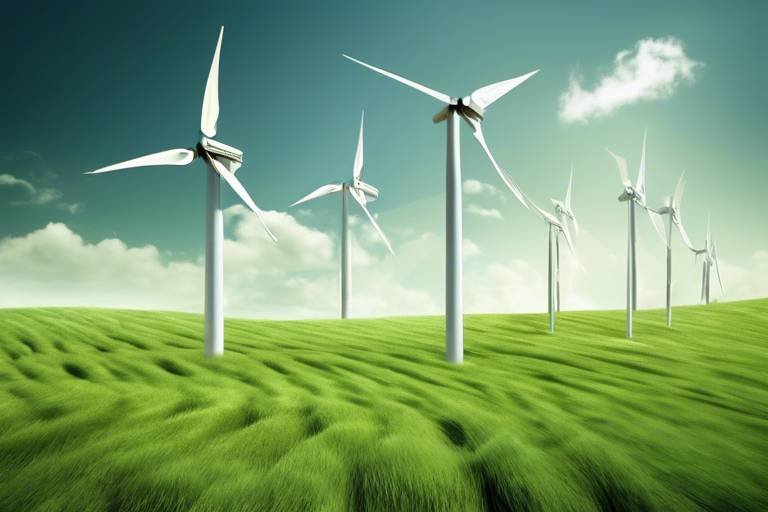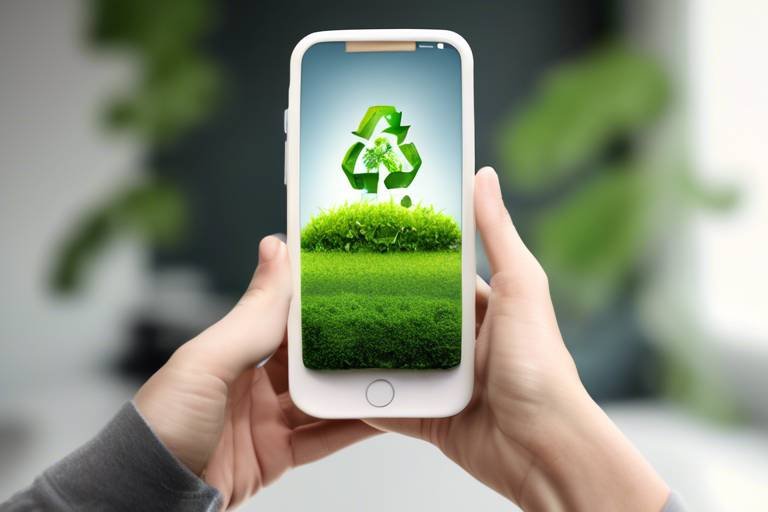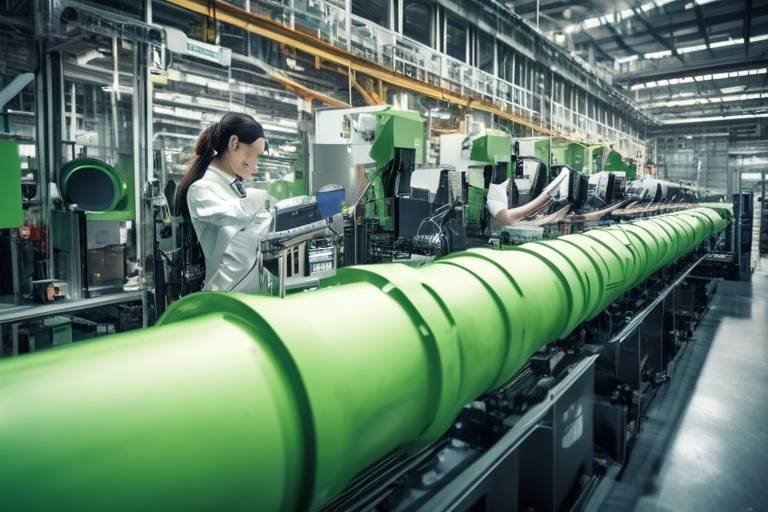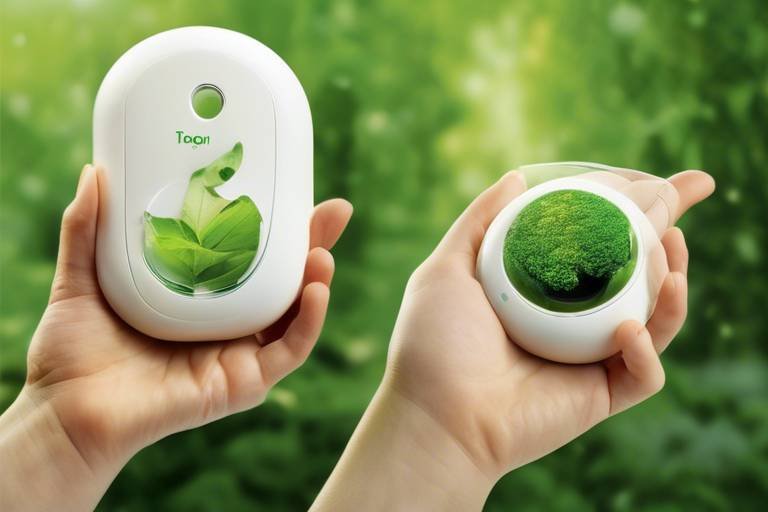Practical Tips for an Eco-Friendly Office
In today’s fast-paced world, creating a sustainable workplace isn't just a trend—it's a necessity. As we become more aware of our environmental impact, the call for eco-friendly practices in every aspect of our lives grows louder. But how can we transform our offices into green havens? This article provides actionable strategies that not only help you contribute to a healthier planet but also enhance your office environment. From reducing waste to conserving energy, these tips are designed to make sustainability a seamless part of your daily routine.
Implementing strategies to minimize paper usage can significantly impact environmental sustainability. Did you know that the average office worker uses about 10,000 sheets of paper each year? That's a staggering number! To combat this, consider exploring digital alternatives. Tools like Google Docs, Dropbox, and project management software can help you go paperless. Additionally, if printing is unavoidable, adopt efficient printing practices: use double-sided printing, print in draft mode, and always ask yourself if a document really needs to be printed. By fostering a paperless office culture, you not only save trees but also reduce clutter and improve organization.
Improving energy efficiency in the office is crucial for reducing carbon footprints. Think of your office as a living organism: every appliance, every light bulb, and every employee contributes to its energy consumption. By making small changes, you can create a significant impact. Start by replacing old appliances with energy-saving models. Look for the Energy Star label, which indicates that the product meets energy efficiency guidelines set by the U.S. Environmental Protection Agency. Furthermore, behavioral changes like turning off lights and unplugging devices when not in use can lead to substantial energy savings.
Utilizing smart lighting systems can optimize energy use in the office. Imagine walking into a room and having the lights automatically adjust to your presence! Discover the benefits of motion sensors and LED lighting, which not only save energy but also provide a modern touch to your workspace. LED lights last longer and consume less power than traditional bulbs, making them a win-win choice for any eco-conscious office.
Maximizing natural light in your office can reduce reliance on artificial lighting. Think about it: sunlight is free and abundant! By designing workspaces that harness sunlight effectively, you can improve both energy efficiency and employee wellbeing. Consider open floor plans, large windows, and light-colored walls that reflect sunlight. Not only does this create a more inviting atmosphere, but it can also boost productivity and morale among employees.
Investing in energy-efficient appliances can lower energy consumption and utility costs. From printers to refrigerators, choosing the right equipment is crucial. Look for appliances that are designed with sustainability in mind. For example, Energy Star-rated devices use less energy and often perform better than their conventional counterparts. By making these smart choices, you can promote sustainability without sacrificing performance.
Engaging employees in sustainability initiatives is vital for fostering an eco-friendly office culture. After all, a sustainable workplace is a team effort! Consider hosting workshops or brainstorming sessions where employees can contribute ideas for green practices. You might be surprised by the creativity and enthusiasm that emerges. Additionally, create a sustainability committee to oversee initiatives and keep the momentum going. When employees feel involved, they’re more likely to embrace eco-friendly practices in their daily routines.
Implementing effective waste management practices can significantly reduce landfill contributions. It’s not just about recycling; it’s about changing the way we think about waste. Start by setting up recycling stations throughout the office, making it easy for everyone to participate. You can also introduce composting initiatives for organic waste. By educating employees on proper disposal methods, you can create a culture of sustainability that resonates throughout the office.
Establishing comprehensive recycling programs can streamline waste management efforts. But how do you get started? First, assess the types of waste your office generates. Then, create designated recycling stations for paper, plastics, and metals. Educate employees on what can and cannot be recycled to avoid contamination. Remember, the key to a successful recycling program is making it easy and accessible for everyone!
Introducing composting in the office can divert organic waste from landfills. Imagine turning your food scraps into nutrient-rich soil! Discover how to implement a successful composting program by providing designated bins for organic waste and educating employees on what can be composted. Not only does composting reduce waste, but it also fosters a sense of community and responsibility among employees.
- What are some easy ways to reduce waste in the office? Start by going digital, implementing recycling programs, and reducing single-use plastics.
- How can I encourage my coworkers to participate in sustainability efforts? Host workshops, create a sustainability committee, and lead by example.
- Are energy-efficient appliances really worth the investment? Yes! They save money in the long run and contribute to a healthier environment.

Reducing Paper Waste
In today's digital age, the idea of going paperless might sound like a distant dream, but it’s more achievable than you think! Implementing strategies to minimize paper usage can significantly impact environmental sustainability. Imagine walking into an office where the clutter of paper is replaced by sleek screens and digital files. Not only does this reduce waste, but it also enhances productivity by making information easily accessible. So, how can you create this paperless paradise? Let’s dive into some actionable strategies!
First off, consider digital alternatives. Tools like Google Drive, Dropbox, or Microsoft OneDrive allow for easy file sharing and collaboration without the need for printed documents. You can create, edit, and store documents all in one place, reducing the need for paper copies. Plus, these platforms offer robust security features, ensuring that your sensitive information remains safe while keeping your workspace tidy.
Another effective strategy is to adopt efficient printing practices. If printing is unavoidable, think about setting your printers to double-sided printing by default. This simple change can cut your paper usage in half! Additionally, educate your team about the importance of reviewing documents on-screen before hitting that print button. You’d be surprised how many pages can be saved just by making this small adjustment.
To further enhance your paper reduction efforts, consider implementing a document management system that allows for easy tracking and retrieval of files. This system can help you digitize existing paper documents, making them searchable and accessible without the need for physical storage. The beauty of this approach is that it not only saves paper but also time, as employees can quickly find the information they need without sifting through piles of paper.
Lastly, foster a culture of sustainability within your office. Encourage employees to think critically about their paper usage and reward innovative ideas for reducing waste. For example, you could host a monthly challenge where teams compete to see who can reduce their paper consumption the most. This not only raises awareness but also promotes teamwork and engagement in sustainability initiatives.
In conclusion, reducing paper waste in your office is not just an eco-friendly choice but also a smart business move. By embracing digital solutions, implementing efficient printing practices, and fostering a culture of sustainability, you can create a workspace that is both productive and environmentally responsible. Remember, every sheet of paper saved is a step towards a healthier planet!

Energy Efficiency
Improving energy efficiency in the office is not just a trend; it’s a necessity for reducing our carbon footprints and fostering a sustainable future. Imagine walking into a workplace that not only boosts productivity but also contributes to a healthier planet—sounds great, right? By adopting energy-efficient practices, you can transform your office into an eco-friendly haven. Start by examining the appliances you use daily; are they energy guzzlers or energy savers? Investing in energy-efficient equipment can lead to significant reductions in energy consumption and lower utility bills. It’s like choosing between a gas-guzzling SUV and a sleek electric car—one option is better for your wallet and the environment.
In addition to upgrading appliances, consider the lighting in your office. Traditional incandescent bulbs may provide light, but they consume a lot of power and have a shorter lifespan compared to modern alternatives. This is where smart lighting solutions come into play. By utilizing motion sensors and LED lighting, you can ensure that lights are only on when needed, significantly cutting down on energy waste. Picture a scenario where the lights automatically turn off in unoccupied rooms—this not only saves energy but also creates a more efficient workspace.
Smart lighting systems are revolutionizing the way we think about office illumination. These systems can adjust brightness based on the time of day or the amount of natural light entering the room. For instance, during sunny days, the lights can dim automatically, allowing you to rely on natural light, which is not only energy-efficient but also enhances employee well-being. Why settle for flickering fluorescent lights when you can have a lighting system that adapts to your needs?
Speaking of natural light, maximizing its use in your office can drastically reduce your reliance on artificial lighting. Consider designing workspaces with large windows or skylights that allow sunlight to flood in. This not only brightens up the area but also creates a more inviting atmosphere for employees. A well-lit office can boost morale and productivity, making it a win-win for everyone involved. Just think about it: who wouldn’t prefer a workspace bathed in natural light over one that feels like a cave?
When it comes to appliances, look for those with the ENERGY STAR label, which indicates they meet strict energy efficiency guidelines. From printers to refrigerators, investing in energy-efficient models can dramatically lower your office’s energy consumption. For example, ENERGY STAR-rated printers consume up to 50% less energy than standard models, and they often come with features that reduce paper waste, such as double-sided printing. It’s like hitting two birds with one stone—saving energy and reducing waste at the same time!
In conclusion, adopting energy-efficient practices in the office is a crucial step towards sustainability. By making conscious choices about lighting and appliances, you can create a workspace that not only conserves energy but also enhances the overall work environment. Remember, every small change counts, and together, these efforts can lead to substantial energy savings and a greener planet.
- What are the benefits of energy-efficient appliances? Energy-efficient appliances consume less energy, which can lead to lower utility bills and reduced environmental impact.
- How can I maximize natural light in my office? Consider using large windows, skylights, and open office layouts to allow more sunlight into your workspace.
- What are smart lighting solutions? Smart lighting systems automatically adjust brightness based on occupancy and natural light, helping to reduce energy consumption.
- Why is employee engagement important for energy efficiency? Engaging employees in sustainability initiatives fosters a culture of awareness and responsibility, leading to more effective energy-saving practices.

Smart Lighting Solutions
When it comes to creating an eco-friendly office, are a game changer. Imagine walking into a workspace that adjusts its lighting based on the time of day or the number of people in the room. Not only does this reduce energy consumption, but it also enhances the overall atmosphere of your office. By utilizing motion sensors and LED lighting, you can create a dynamic environment that promotes productivity while being kind to the planet.
Let's dive deeper into how these technologies work. Motion sensors detect when someone is present in a room and automatically turn the lights on or off. This means that you no longer have to worry about lights being left on in empty conference rooms or restrooms. Imagine the savings on your electricity bill! According to studies, motion sensors can reduce energy usage by up to 30%. That's not just good for your budget; it's fantastic for the environment.
Now, let’s talk about LED lighting. Unlike traditional incandescent bulbs, LEDs use significantly less energy and last much longer. In fact, an LED bulb can last up to 25 times longer than a standard bulb. This means fewer replacements and less waste. Plus, LEDs emit less heat, which can help keep your office cooler, reducing the need for air conditioning during those hot summer months.
But why stop there? Consider implementing a smart lighting control system. These systems allow you to program different lighting settings based on the time of day or specific activities. For example, you might want bright, white light for tasks that require focus in the morning, and warmer, softer light for collaborative meetings in the afternoon. This flexibility not only enhances employee comfort but also contributes to energy conservation.
To give you a clearer picture, here’s a simple comparison of traditional lighting versus smart lighting solutions:
| Feature | Traditional Lighting | Smart Lighting Solutions |
|---|---|---|
| Energy Efficiency | Low | High |
| Longevity | Short (1,000 hours) | Long (25,000+ hours) |
| Control Options | Manual | Automated, programmable |
| Cost Savings | Minimal | Significant |
Incorporating smart lighting solutions not only helps in reducing your office’s carbon footprint but also fosters a more engaging and productive work environment. So, why not take the plunge? By investing in these technologies, you're not just making a choice for your office; you're making a choice for the planet. And let’s be honest, who wouldn’t want to work in a space that feels both modern and environmentally conscious?
- What are the initial costs of installing smart lighting? While the upfront costs can be higher than traditional lighting, the long-term savings on energy bills often outweigh these initial investments.
- Can I retrofit my existing lighting with smart technology? Yes! Many smart lighting solutions are designed to work with existing fixtures, making it easier to upgrade.
- How can I convince my employer to invest in smart lighting? Presenting data on energy savings, improved employee productivity, and environmental benefits can make a compelling case.

Natural Light Utilization
Maximizing natural light in your office is not just a trendy design choice; it's a game-changer for both energy efficiency and employee well-being. Imagine walking into a workspace that is bathed in sunlight, where the warm rays lift your spirits and invigorate your productivity. By harnessing the power of sunlight, you can create a vibrant atmosphere that reduces the need for artificial lighting, ultimately leading to substantial energy savings. But how do you achieve this? Let's dive into some practical strategies!
First off, consider the layout of your office. Position workstations near windows to allow employees to benefit from natural light throughout the day. Not only does this improve mood and morale, but it also reduces eye strain and fatigue that often come from working under harsh fluorescent lights. Think of it as giving your team a little piece of the outdoors, right at their desks!
Additionally, you can enhance natural light penetration by using light-colored walls and furnishings. Light hues reflect sunlight, making the space feel brighter and more open. If your office has darker spaces, consider installing mirrors or glass partitions that can help bounce light around the room. It's like playing a game of light tag, where you're constantly trying to capture and redirect those sunny rays!
Another effective strategy is to use window treatments wisely. Instead of heavy drapes that block light, opt for sheer curtains or blinds that can be adjusted throughout the day. This allows for flexibility, enabling employees to control the amount of light entering their space without sacrificing comfort. Plus, it adds a touch of style to your office decor!
It's also important to keep in mind the seasonal changes in daylight. During the summer months, you might find that the sun's position creates glare at certain times of the day. Consider investing in adjustable shading solutions that can help mitigate this issue, ensuring that your team stays comfortable and focused.
Lastly, don't forget to encourage employees to take advantage of outdoor spaces during breaks. A quick stroll outside not only rejuvenates the mind but also allows for a healthy dose of natural light exposure. Think of it as a mini-vacation from the office, where they can recharge and return with renewed energy!
In summary, utilizing natural light in your office is about more than just aesthetics—it's an investment in your team's health and productivity. By thoughtfully designing your workspace to maximize sunlight, you're not just creating a pleasant environment; you're also contributing to a more sustainable future. So, let the sunshine in and watch your office thrive!
- How can I measure the amount of natural light in my office? You can use a light meter to measure the intensity of light in different areas of your office, helping you identify spots that may need improvement.
- What are some low-cost ways to increase natural light? Simple changes like rearranging furniture, painting walls in lighter colors, or using reflective surfaces can significantly enhance natural light without breaking the bank.
- Are there specific plants that thrive in natural light? Yes! Plants like succulents, spider plants, and peace lilies do well in bright, indirect light and can add a touch of nature to your workspace.

Energy-Efficient Appliances
Investing in is not just a smart financial decision; it's also a significant step towards creating a sustainable office environment. These appliances are designed to consume less energy while maintaining optimal performance, which means you can reduce your carbon footprint without compromising on productivity. Imagine replacing that old, energy-hogging printer with a sleek, modern model that uses half the electricity. Not only do you save on utility bills, but you also contribute to a healthier planet.
When selecting energy-efficient appliances, look for the Energy Star label. This certification indicates that the product meets strict energy efficiency guidelines set by the U.S. Environmental Protection Agency. You might be surprised to learn that using Energy Star certified appliances can save you up to 30% on energy costs compared to conventional models. It's like finding money in your pocket every month!
Here are some common types of energy-efficient appliances you should consider for your office:
- Printers: Look for models that have duplex printing capabilities, allowing you to print on both sides of the paper, which not only saves paper but also reduces energy consumption.
- Computers: Opt for laptops or desktops that are designed to be energy-efficient. Many come with power-saving modes that significantly reduce electricity use when the device is idle.
- Refrigerators: If your office has a kitchen area, consider an Energy Star certified refrigerator. These models use less energy and maintain optimal cooling, which is essential for food safety.
- HVAC Systems: Upgrading to an energy-efficient heating, ventilation, and air conditioning system can lead to substantial savings on your energy bills while ensuring a comfortable workspace.
Additionally, it's essential to implement regular maintenance on these appliances to keep them running efficiently. For example, cleaning the filters in your HVAC system or ensuring that your refrigerator coils are free of dust can significantly enhance their performance and lifespan. Think of it as giving your appliances a little TLC – they’ll thank you by working more efficiently!
In summary, are a win-win for your office. They not only help you save money but also play a crucial role in reducing environmental impact. By making conscious choices about the appliances you use, you can create a workspace that is both productive and eco-friendly. So, the next time you’re in the market for office equipment, remember that every little bit counts. Your choices can lead to a more sustainable future!
Q: What are energy-efficient appliances?
A: Energy-efficient appliances are designed to use less energy while providing the same level of performance as standard appliances. They often carry the Energy Star label, indicating adherence to strict energy efficiency guidelines.
Q: How can I tell if an appliance is energy-efficient?
A: Look for the Energy Star label or check the appliance's energy guide, which provides information about its energy consumption compared to similar models.
Q: Do energy-efficient appliances really save money?
A: Yes, energy-efficient appliances can significantly reduce energy bills. Many users report savings of up to 30% on their energy costs after switching to Energy Star certified products.
Q: Are there any other benefits to using energy-efficient appliances?
A: Besides saving money, using energy-efficient appliances helps reduce your carbon footprint and contributes to a healthier environment, making it a responsible choice for both your office and the planet.

Employee Engagement
When it comes to fostering an eco-friendly office culture, engaging employees is not just a bonus; it’s a necessity. Think of your workplace as a garden—without the right amount of care and attention, it simply won’t flourish. How can we cultivate this garden of sustainability? By getting everyone involved! Encouraging participation in environmental initiatives not only boosts morale but also creates a sense of ownership. When employees feel that their contributions matter, they are more likely to take action.
One effective way to engage employees is through the establishment of a sustainability committee. This group can be responsible for organizing events, such as eco-friendly challenges or awareness campaigns. Imagine hosting a month-long competition where teams compete to reduce their carbon footprints. Not only does this promote teamwork, but it also instills a sense of friendly competition that can make sustainability exciting.
Moreover, regular workshops can be pivotal in keeping sustainability at the forefront of everyone’s minds. These workshops can cover various topics, such as recycling best practices, energy conservation techniques, and even DIY projects for upcycling office materials. When employees have the opportunity to learn and engage in hands-on activities, they are more likely to internalize these practices and implement them in their daily routines.
To further enhance engagement, consider implementing a reward system that recognizes employees who actively participate in sustainability efforts. This could be as simple as acknowledging their contributions during team meetings or offering small incentives, like eco-friendly products or extra time off. Here’s a quick table to illustrate potential rewards:
| Reward Type | Description |
|---|---|
| Recognition | Acknowledge efforts in team meetings or newsletters. |
| Eco-Friendly Products | Gift items like reusable bags or bamboo utensils. |
| Extra Time Off | Offer an additional day off for outstanding contributions. |
Additionally, creating a feedback loop can help maintain momentum. Regularly solicit input from employees about sustainability practices—what’s working, what isn’t, and what ideas they have for improvement. This not only shows that you value their opinions but also encourages them to think critically about how they can contribute to a greener workplace.
Lastly, don’t underestimate the power of communication. Use newsletters, bulletin boards, or even social media platforms to share updates on sustainability initiatives and their impacts. When employees see the tangible results of their efforts, it reinforces the importance of their participation and motivates them to keep pushing for a greener office.
Engaging employees in sustainability is a continuous journey, not a one-time event. By creating an inclusive environment where everyone feels empowered to contribute, you’ll cultivate a thriving eco-friendly workplace that benefits both the planet and your team.
Q: How can I motivate my team to participate in sustainability initiatives?
A: Start by creating a sustainability committee and organizing engaging activities, such as competitions or workshops. Recognizing and rewarding participation can also enhance motivation.
Q: What are some quick wins for promoting sustainability in the office?
A: Implementing recycling stations, reducing single-use plastics, and encouraging the use of digital documents are great starting points.
Q: How can I measure the impact of our sustainability efforts?
A: Track metrics such as waste reduction, energy savings, and employee participation rates to assess the effectiveness of your initiatives.

Waste Management Practices
Implementing effective waste management practices in your office is not just a good idea; it's a necessity for creating a sustainable workplace. The reality is, every piece of paper, plastic bottle, or coffee cup that gets tossed in the trash contributes to overflowing landfills. But fear not! By adopting smart waste management strategies, you can drastically reduce your office's environmental footprint while fostering a culture of sustainability among your employees.
One of the most impactful actions you can take is to establish comprehensive recycling programs. Think about it: how many items in your office could be recycled instead of thrown away? From paper and cardboard to plastics and electronics, a well-structured recycling program can streamline waste management efforts and significantly reduce landfill contributions. It's essential to set up clearly marked recycling stations throughout the office, making it easy for everyone to participate. Moreover, educating employees on proper disposal methods is crucial. You might consider hosting a fun workshop or distributing informative flyers that outline what can and cannot be recycled.
Another effective strategy is introducing composting solutions in the workplace. Did you know that organic waste makes up a significant portion of what ends up in landfills? By composting food scraps and biodegradable materials, you can divert this waste from the trash and turn it into nutrient-rich compost for gardens or landscaping. Implementing a successful composting program might seem daunting at first, but it can be as simple as placing a compost bin in the kitchen area and educating employees on what can be composted. This not only reduces waste but also encourages a sense of teamwork and responsibility among your staff.
To give you a clearer picture, here’s a quick table summarizing the key components of effective waste management practices:
| Practice | Description | Benefits |
|---|---|---|
| Recycling Programs | Organized collection of recyclable materials throughout the office. | Reduces landfill waste, conserves resources, and promotes sustainability. |
| Composting Solutions | Collection of organic waste for composting instead of disposal. | Reduces organic waste in landfills and creates useful compost. |
| Employee Education | Training sessions on recycling and composting best practices. | Increases participation and awareness of sustainability issues. |
In addition to these practices, it's essential to minimize the use of single-use plastics in your office. This can be as simple as encouraging employees to bring their own reusable water bottles and coffee mugs. You could even consider providing incentives for those who participate. Every small change can lead to significant results, and when everyone gets involved, it creates a sense of community and shared purpose.
Ultimately, the goal of these waste management practices is to cultivate a workplace that not only prioritizes the environment but also enhances employee morale and productivity. When employees see that their company cares about sustainability, it fosters a sense of pride and responsibility. So, why not take the first step today? Start discussions about waste management practices in your next team meeting, and watch as your office transforms into a beacon of eco-friendliness!
- What materials can be recycled in the office? Most offices can recycle paper, cardboard, plastics, and metals. Check with your local recycling guidelines for specifics.
- How can I encourage my coworkers to participate in recycling and composting? Organize fun challenges or provide informative sessions about the benefits of these practices to engage your team.
- Is composting difficult to implement in an office setting? Not at all! Start small with a compost bin in the kitchen, and educate your team on what can be composted.
- What are the benefits of reducing single-use plastics? Reducing single-use plastics helps decrease waste, lowers pollution, and promotes a healthier environment.

Recycling Programs
Establishing comprehensive in your office is not just a trend; it's a necessity for promoting a sustainable work environment. Imagine walking into an office where every piece of paper, plastic bottle, and cardboard box has a designated home. This is the kind of organized and eco-friendly atmosphere that a well-implemented recycling program can create. Not only does it help reduce waste sent to landfills, but it also fosters a sense of responsibility and community among employees.
To kickstart your recycling initiative, it's essential to first assess the types of materials your office generates. A simple audit can reveal surprising insights into your waste production. For instance, you might discover that a significant portion of your waste is recyclable, such as:
- Paper and cardboard
- Plastics (like bottles and containers)
- Metals (cans and aluminum)
- Electronics (old devices and batteries)
Once you identify the materials, the next step is to set up clearly labeled recycling stations throughout your office. These stations should be easily accessible and strategically placed near common areas like kitchens, break rooms, and workstations. Consider using colorful bins that distinguish between different types of recyclables. This visual cue can significantly enhance participation rates, as employees will be more inclined to recycle when it’s made simple and straightforward.
Education plays a pivotal role in the success of your recycling program. It's not enough to just have the bins; your team needs to understand what can and cannot be recycled. Hosting a fun, interactive workshop can be an effective way to engage employees. You could even gamify the experience by creating a competition to see which department can recycle the most in a month. This not only raises awareness but also builds camaraderie among coworkers.
Furthermore, consider partnering with local recycling companies to ensure that your materials are processed correctly. Having a reliable partner can provide peace of mind and streamline the recycling process. You can also explore the option of organizing regular collection days for electronics and other hard-to-recycle items, making it easier for everyone to participate.
In conclusion, recycling programs are a vital component of an eco-friendly office. By creating a well-structured and engaging recycling initiative, you can significantly reduce your workplace's environmental impact while fostering a culture of sustainability. Remember, every small effort counts, and together, your team can make a big difference!
Q: What materials can be recycled in the office?
A: Common recyclable materials include paper, cardboard, plastics, metals, and electronics. Always check with your local recycling guidelines to ensure proper disposal.
Q: How can I encourage my coworkers to participate in the recycling program?
A: Engage your coworkers through workshops, competitions, and clear communication about the benefits of recycling. Making it a team effort can boost participation.
Q: What should I do with items that are not recyclable?
A: For items that cannot be recycled, consider reducing their use or finding alternative products. You can also look into proper disposal methods or donation options for usable items.

Composting Solutions
Composting in the office is more than just a trendy buzzword—it's a **powerful solution** for reducing waste and nurturing the environment. Imagine transforming your kitchen scraps and office organic waste into nutrient-rich compost that can enrich soil and support plant growth. By implementing a composting program, you not only divert organic materials from landfills but also contribute to a healthier ecosystem. So, how do you get started on this green journey?
First, it’s essential to understand what materials can be composted. Generally, compostable items include:
- Fruit and vegetable scraps
- Coffee grounds and filters
- Eggshells
- Grass clippings and leaves
- Cardboard and paper (non-coated)
However, be cautious and avoid composting items like meat, dairy, and oils, which can attract pests and create odors. A well-balanced compost pile requires a mix of greens (nitrogen-rich materials) and browns (carbon-rich materials) to decompose effectively.
Next, consider the logistics of implementing a composting program in your office. Start by designating a specific area for composting. This could be a small bin in the kitchen or break room where employees can easily dispose of their organic waste. You may also want to invest in a **compost bin** or a **worm bin** for indoor composting, especially if space is limited. These options are not only space-efficient but also minimize odors and pests.
To ensure the success of your composting program, **employee education** is key. Host a small workshop or distribute informative flyers that outline what can and cannot be composted. Visual aids, such as posters showing compostable materials, can serve as constant reminders. Additionally, consider assigning a compost champion—someone enthusiastic about sustainability—to oversee the program and encourage participation among colleagues.
One of the most rewarding aspects of composting is witnessing the transformation of waste into valuable compost. After a few months, you can use this compost to enrich plants in your office or even donate it to local community gardens. Not only does this close the loop on waste, but it also fosters a sense of community and responsibility among employees.
In conclusion, composting solutions in the office can lead to significant environmental benefits while also promoting a culture of sustainability. By taking small, actionable steps, you can create a **greener workplace** that inspires others to follow suit. So, are you ready to roll up your sleeves and start composting?
Q: What can I compost in the office?
A: You can compost fruit and vegetable scraps, coffee grounds, eggshells, and certain types of paper. Avoid meat, dairy, and oils.
Q: How do I manage odors from composting?
A: Ensure you balance greens and browns, aerate the compost regularly, and keep the bin covered to minimize odors.
Q: Can I compost in a small office?
A: Yes! You can use small compost bins or worm bins that are perfect for limited space and help control odors.
Q: What are the benefits of composting?
A: Composting reduces landfill waste, enriches soil, and promotes a sustainable workplace culture.
Frequently Asked Questions
- How can we reduce paper waste in the office?
Reducing paper waste starts with embracing digital solutions. Encourage your team to use cloud storage and digital communication tools instead of printed memos. Additionally, implement policies for double-sided printing and set printers to default to black and white to save ink and paper.
- What are some energy-efficient appliances for an eco-friendly office?
Look for appliances that have the ENERGY STAR label, which indicates they meet energy efficiency guidelines. Options like energy-efficient printers, computers, and refrigerators can significantly lower your office's energy consumption while maintaining performance.
- How can we engage employees in sustainability initiatives?
Engagement can be fostered through regular workshops and team challenges focused on sustainability. Create a green team within your office to lead initiatives and encourage participation through incentives. Sharing success stories can also motivate others to get involved!
- What are best practices for implementing recycling programs?
To set up an effective recycling program, start by placing clearly labeled recycling bins in convenient locations. Educate employees on what materials can be recycled and provide regular reminders. You can also schedule training sessions to help staff understand the importance of recycling.
- Can composting be implemented in a small office?
Absolutely! Even small offices can benefit from composting. Start by designating a compost bin for organic waste like food scraps and paper products. Partner with a local composting service if you don’t have the space for a compost pile, and educate your team on what can and cannot be composted.
- How does maximizing natural light benefit the office?
Maximizing natural light not only reduces energy costs but also enhances employee well-being and productivity. Studies show that natural light can improve mood and focus, leading to a more vibrant and dynamic workplace. Consider rearranging desks to face windows or using glass partitions to allow light to flow through.

